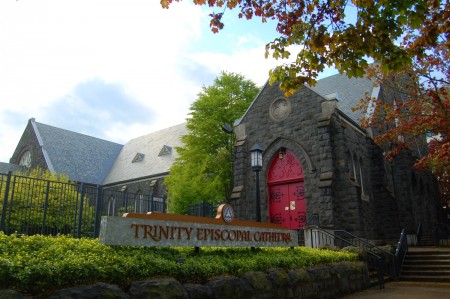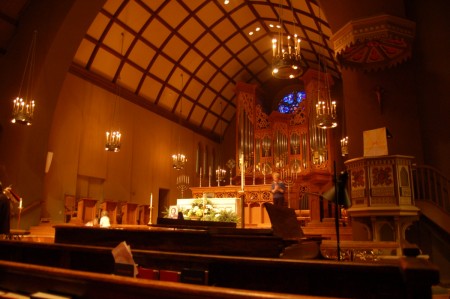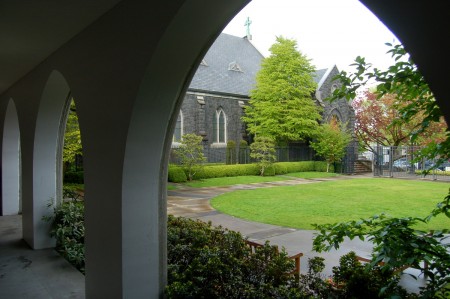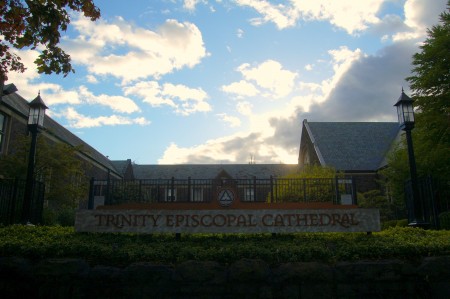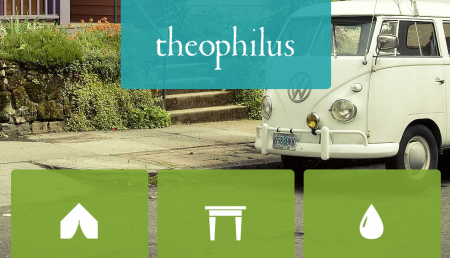In 1940, the year France was trampled under the heel of Hitler’s army, Roger Schutz hopped on his bike and pedaled 90 miles west from neutral Geneva, Switzerland to the French town of Taizé. There he settled, adjacent to Nazi-occupied territory, to found a monastery dedicated to bringing spiritual healing to that war-ravaged land.
And then a funny thing happened. Though Frère Roger was Protestant, his community was soon joined by Reformed, Anglican and Roman Catholic monks whose driving mission was, basically, “Can’t we all just get along—doctrinally, racially, geopolitically?” Shorn of dogma and cant, his message was simple. As he once said, “We have come here to search or to go on searching through silence and prayer, to get in touch with our inner life.”
Blasting apart preconceptions about how a monastery works, Taizé is an ecumenical monastic community, making it the world’s only triple oxymoron. Last year, over 100,000 young people made a pilgrimage to the site. If you want to taste Taizé for yourself, there’s probably a church near you that offers a service based on its liturgy. Be wise. Go to one. Especially if you’re into candles, because typically, that’s the only light they use.
That’s what we did last Sunday. After Googling “Taize Portland Oregon” (Google doesn’t need the fancy French “é”) and sifting through the dozens of choices, we settled on Trinity Episcopal Cathedral.
Attending a Taizé service is easier and more stress-free than you may think. If you already belong to a religious tradition, chances are, you won’t have to change. Taizé services are offered as an adjunct service in churches of many faiths. Think of it as a supplement to your primary spiritual path—a metaphysical version of Aflac.
Unlike regular church services, there really isn’t a sermon. Focusing on the novel concept of pure spirituality, it features prayer, music and lots of silence. Our service was led by a small woman with salt and pepper hair and a black cassock, who could barely see over the ornate gilded lectern. After delivering a few introductory comments to set the tone (“silence is the first language of God,” “the purpose of Taizé is to find awareness of the sacred that is all around us,” “religious icons are there to draw you into the presence of the holy”) and a few bits of business (“come forward to write in our book the names of those you would like intercessory prayers for”), we were off and running. Actually, we sat quietly. Even Amanda’s kids—not the only miracle of the evening.
The service itself began with the ringing of a bowl-shaped gong, the kind you see at Buddhist temples. After that, it was a sort of round robin of prayers and music—chanting, really, in which a short phrase is repeated, giving the music itself an aspect of meditation—led by a choir and a coronet-piano-double bass ensemble—a perfect arrangement for midcentury devotional music, the era in which most of the chants were written. (Imagine: Aaron Copeland or Ralph Vaughan Williams, with words by Jesus Christ) The lyrics make a point to avoid theology; in so doing, they transcend it:
While you still have the light, believe in the light
and you will become children of the light
You’d have to be an irreformable cynic to argue with that. As Frère Roger says, “Nothing is more conducive to a communion with the living God than a meditative common prayer with, as its high point, singing that never ends but continues in the silence of one’s heart when one is alone again.”
At roughly the halfway point, a bowl of incense was burned, signaling that it was time for the prayers of intercession. In unison, the congregants (there were about 75) read a printed list of the names of those for whom intercessory prayers had been requested in the Big Book at the front of the hall. Sort of like Garrison Keillor’s greetings during Prairie Home Companion, but spoken to God instead of a studio audience. Just a few highlights:
Dakota, healing
Tom and Darlene, rich experiences
All men and women living in Old Town, may they be treated with dignity
People of Japan
People of Libya
Alec
Children orphaned by AIDS in Africa
Cathy and family
That we be open
Spring blossoms and renewal
Sherie
My patients
Janet, forgiveness
Lewis and Doris, health and happiness
Holly
Gerik
Laurie
Billie, Carter and Julie, pilgrimage to Turkey
Love and Joy for Beth and Anne
Sharin
Rose
Andrew
Meaningful work for Evan
Guy
Tom, my dear husband
Joyce, stability and love
Falling in love
I had a couple of additions I wish I’d made to the list:
Max, love and autonomy
Liza, love, piss and vinegar
Do you ever need a hug? If so, you’re going to love the next part: the laying on of the hands, to which, according to the program, “all are invited.” With “all” as the operative word, even I could approach. Take that, Jehovah’s Witnesses!
A cadre of aunt Marthas and uncle Bobs gathered in sets of two at the altar rail to receive anyone who felt moved to come forward to get a hug and a prayer, with the ministers’ hands placed gently on their heads and shoulders. The choir continued to sing—partly to sustain the mood and partly, I suspect, to muffle the prayers and whispered conversations at the altar, lending them privacy in the vast cathedral auditorium.
As men and women filed forward to take their turn, they approached the devotional duos with reverence; they returned to their seats smiling, or perhaps dabbing tears from their eyes, or both. I have no idea what was said in those pow-wows, but I can guess. What we so often need to hear from our aunt Marthas and uncle Bobs (if we’ve ever been lucky enough to have them) is that simplest of benedictions: You’re Going To Be Okay.
I’m a sucker for blessings and, like Amanda, I regret that I didn’t take advantage of the laying on of the hands. That just means we’ll have to go back. Unlike other churches that encourage the exhibitionistic show of emotionalism (yes, Portland Pentecostals, I’m talking to you), these individuals seemed shyly startled by their own expressions; it was as if they’d captured, by accident, their true nature reflected in a shop window—surprised, if you will, by joy.
At every point in the service, there were opportunities to veer off into interfaith Kumbaya sappiness. But that never happened. Though I’m sure that there are as many different ways to conduct a Taizé as there are Taizé services, the one we saw was carried out with solemn dignity, poise and contemplation. It was a renewal, a perfect conclusion to a springtime evening.
Frère Roger (why do I like writing that so much?) spent his life working to reconcile all churches of Christianity, and the favor was returned. Remarkably, though a Protestant himself, he received the sacraments every morning at a Catholic mass—communion usually being reserved for confirmed Catholics. Indicating their approval of his ecumenical stand, both Popes John Paul II and Benedict XVI also administered the Eucharist to him.
It almost requires a state of grace to break down those barriers, and that seems to me to be the secret of Frère Roger’s success. As he said, “Since my youth, I think that I have never lost the intuition that community life could be a sign that God is love, and love alone.”
It seems that all the great spiritual leaders from the Dalai Lama to Gandhi to Frère Roger agree on one point: when you strip away the conventions and the cloth, the doctrine and the debate, you’re left alone with the one thing you’ll ever need, the one thing that constantly surrounds us, though its form is so simple it often goes right by and you never knew it. But, as Sunday’s Taizé service demonstrated, in silence and candlelight and with the right music and an open intent, if you’re lucky, you might find what you’re really looking for: love.
——
What do you think? Have you been to a Taizé service? Want to share a thought? Drop a line in the comments section.
